
Station Name: STRETTON-ON-FOSSE[Source: Darren Kitson]
Tickets Michael Stewart. Route map drawn by Alan Young. Proof reading by Alan Lawrence. CLICK HERE FOR A BRIEF HISTORY OF THE See also Shipston-on-Stour, Longdon Road, Stretton-on-Fosse and Moreton-in-Marsh Stretton on Fosse Station: Gallery 1
Early 20th C - 31 August 1952 fosse_old10.jpg) fairly early photograph of which the subject was obviously the Golden Cross inn. The weighbridge and office was provided in 1906, the photograph being probably taken not long afterwards. There is a 'whiteout' problem with this image and the chimney pots on the east (to the right) end of the building are invisible. No photographs have come to light showing pots on the west end chimney stack, however. Very few photographs are known to exist showing the inn sign in situ, it being absent in the majority. Later photographs show the bracket, from which the sign was suspended, to have also been removed so perhaps the sign was relocated to the end wall of the building. These signs famously swung in the wind and tended to squeak so perhaps there was complaints from overnight guests. The bicycle is rather thoughtlessly obstructing the doorway. The field gate in the left background and to the right of the level crossing is still there to this day (2024) although partially engulfed by the hedges.
Photo from Jim Lake collection 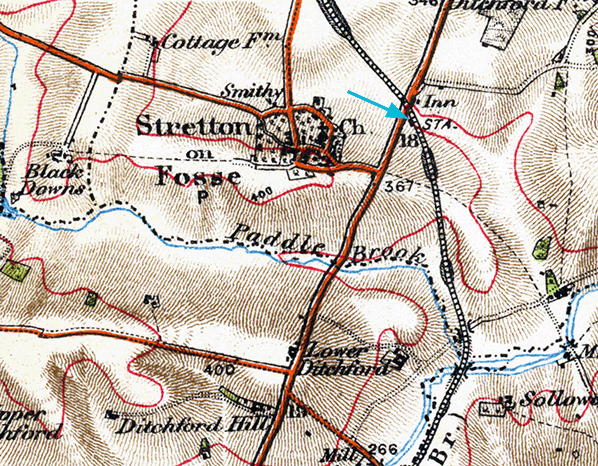 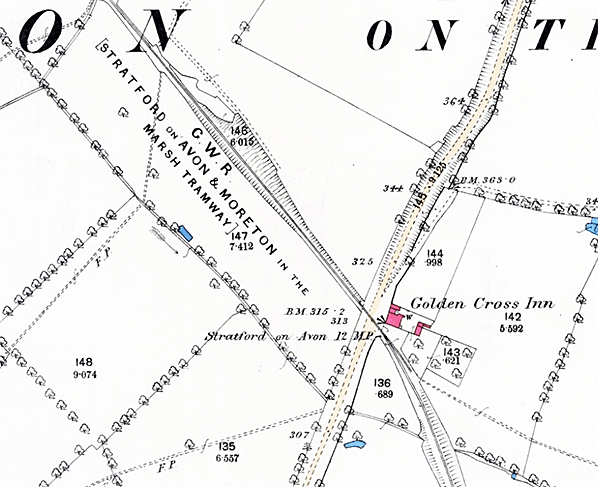
The 1887 OS 1:25000 map showed what would become the site of Stretton-on-Fosse station five years later. The Ordnance Survey at this time was not good at railway company names and mistakes were common. The correct title of what in 1887 was still the horse tramway was the ‘Stratford & Moreton Railway’. At this time the location was referred to as "Golden Cross request stop" and apart from the inn there was nothing else there. A short siding is shown on the south-east side of the road crossing and this is something of a mystery. It is thought the GWR removed this siding during the conversion to railway status but then decided to provide a new siding. A record survives implying the new siding was provided in 1890, with the request stop thereafter known, at least officially, as "Stretton-on-Fosse Siding" but still with no passenger facilities.
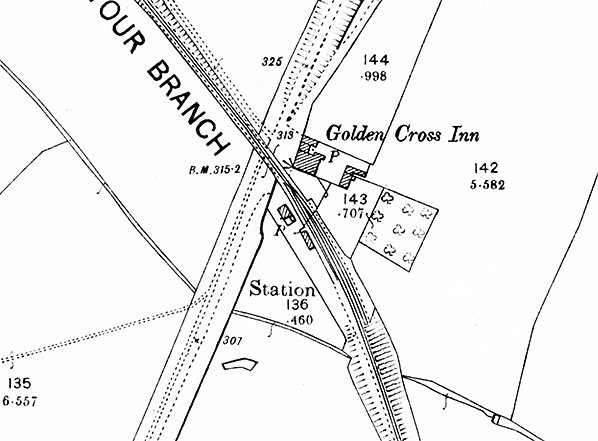
By the time of the 1902 OS map a transformation of sorts had occurred. A longer siding is now present as is the station platform and its wooden building. The house has also appeared; is it thought to have begun life in 1889 as a standard crossing keeper's cottage only to be extended in 1892 to serve as the stationmaster's house. The Ordnance Survey had by now used the title "GWR Shipston-on-Stour Branch". One change is evident at the Golden Cross. The 1887 map showed it as having a well (W) but these 1902 maps shows a pump (p) had been installed. Gone were the days of lowering a bucket into the well and then hauling it out again, hopefully full of water.
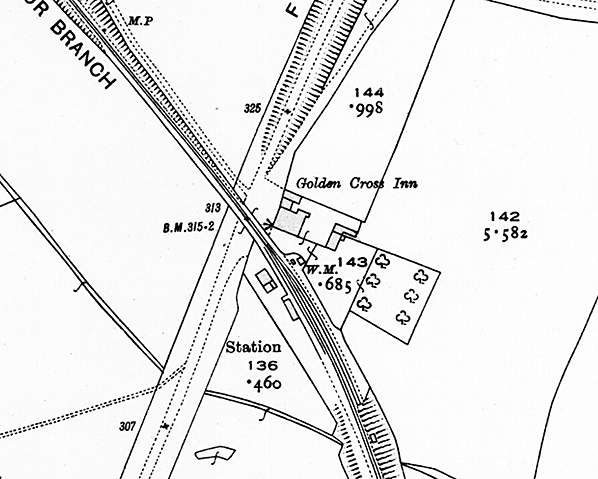 By the time of this 1923 OS map a weighing machine (W.M.) and another hut has appeared opposite the station platform with a further hut appearing to the south, just beyond the end of the siding. There was a curious fondness at Stretton-on-Fosse for various huts at various times, one of which housed the gangers 'rail velocipede' and the later 'pump trolley' and trailer. Following the progress at Stretton-on-Fosse via this series of maps, it is perhaps strange to think that just six years later, in 1929, the Shipston-on-Stour passenger train service would be withdrawn. fosse_old1.jpg)
This view is from a postcard which had been used in October 1910 so the date of the photograph will of course have been earlier and perhaps by a few years. The inn sign on the Golden Cross can be seen at far right. The sharp eyed viewer will notice the rails of the siding are outside keyed while the rails of the running line are inside keyed. This 'one or the other' theme could be found throughout the Shipston-on-Stour branch. No doubt when the branch was relaid secondhand track materials were brought in from wherever they happened to be available. The platform was wood-faced and the edging was of timber baulks, with the platform surface probably being of cinders or stone chippings. The usual accoutrements found on rural stations can be seen, namely a platform barrow, a sack barrow and a couple of milk churns. There is another barrow of the wheelbarrow type at the far end of the platform. There being no platform canopy the bench seat is not ideally placed, being exposed to the weather, and one suspects it was too large to be manhandled through the single doorway into the building. As was the case at Longdon Road and Shipston-on-Stour the building sat upon a rearwards extension of the platform. Unfortunately none of the posters are readable. The point rodding alongside the platform was operated from a ground frame near the level crossing. Stretton-on-Fosse had just two sets of points, both of which are seen here of which that nearest the camera was a trap point for the siding. Clearly seen are the level crossing gates which overlapped when closed to the railway.
Copyright photo from John Alsop collection fosse_old4.jpg) Another view from October 1910 and facing towards Moreton-in-Marsh. This time much of the platform clutter is in different positions. Both running-in boards can be seen and that at the far end of the platform was later removed. Quite why two were thought necessary is a mystery as Longdon Road and Shipston-on-stour somehow muddled through with just one each. Also mystifying is why one board was removed but perhaps its backboard was required elsewhere, at a railmotor halt maybe as these were starting to be provided at around this time with cheapness being all important. Note the water tank on the roof of the lavatory, the lavatory being accessed via an end door hidden from view by the solid fencing. No doubt it is the stationmaster (or "booking constable" - take your pick [see main text]) posing for the camera with his child and dog. A wagon stands on the siding and a horse-drawn cart has been backed up to it. No dock or goods platform was provided at Stretton-on-Fosse. The loading gauge appears to be of the fixed type and later photographs show a standard, adjustable GWR type to have been present.
Photo from John Mann collection fosse_old5.jpg)
Facing towards Shipston-on-Stour sometime after withdrawal of the passenger service in 1929, the only evidence of the station being closed to passengers, in this scene, is the partially dismantled oil lamp on the platform. The running-in board was to remain in situ for many years after 1929. The gates on the the right gave access to the goods yard, such as it was, and the condition of the siding railheads suggests goods traffic was infrequent. Note the road van parked by the end of the Golden Cross inn and the level crossing gates, overlapping when closed to the railway, can be seen. As there was no signalling these crossing gates were not locked. Instead a metal hoop hinging from one gate over the post of another was used to keep the gates in position. One such hoop is visible here.
Photo from John Mann collection fosse_old6.jpg) Facing towards Moreton-in-Marsh sometime after withdrawal of the passenger service in 1929. Compare this to the similar view taken in October 1910. The roses growing through the fence add a smidgen of horticultural delight to the otherwise somewhat forlorn scene. On the platform just beyond the building stands a drinking water can; this will be taken away by the branch goods train for refilling and a full replacement deposited for the occupants of the cottage. The loading gauge over the siding is now of the adjustable GWR type.
Photo from John Mann collection fosse_old9.jpg)
Another view facing towards Moreton-in-Marsh sometime after withdrawal of the passenger service in 1929 and this time showing a wagon on the goods siding. The wagon is covered by a tarpaulin, No. 102930. This is not the wagon number. Tarpaulins came in two types; expensive and not quite so expensive and all had an inventory number along with the name or initials of the owning railway company. In essence these were anti theft measures and in general all portable items of railway owned property were marked in a similar fashion. At left foreground can be seen the 2-lever ground frame. It operated the points for the siding and the trap point, which latter is barely visible here. The round frame can be seen in several photographs although the levers are often difficult to see due to being 'camouflaged' by the adjacent fence posts.
Photo from John Mann collection fosse_old3.jpg)
In April 1934 the camera was looking across the goods siding towards Shipston-on-Stour. The camera is facing north-west but Shipston-on-Stour is to the east north-east, in other words a few miles roughly to the right of the camera such was the indirectness of the Shipston-on-Stour branch - a legacy of the reuse of sections of the former horse tramway. Behind the station building can be seen, in part, the roof of the cottage with its two-storey rearwards extension and unequal roof heights. "Extension" is actually a misnomer for insofar as is known the cottage was built to this style.
Copyright photo from John Alsop collection fosse_old2.jpg)
This photograph was taken at the same time as the other April 1934 view but from a slightly different vantage point. A tarpaulin, perhaps from a wagon, is draped over the fence and note the ladder hanging on the platform face. The ladder was probably used to access goods wagons as Stretton-on-Fosse had no goods platform or dock. The running-in board is still present some five years after the withdrawal of the passenger service. To the right the two posts and the weigh office are leaning back, the result of ground movement which was evident on this section of the line.
Copyright photo from John Alsop collection 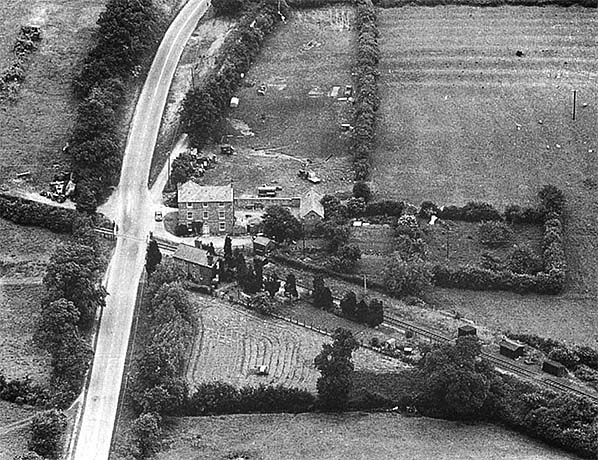
Stretton-on-Fosse closed to all traffic on 1 June 1941 with the station building and siding thought to have been removed during 1947, this view dating from sometime subsequently. While the stationmaster's house is a long way from the camera we nevertheless can see the rear of the building with its two-storey extension. It is possible the extension, with its lower roof, was a separate cottage for a level crossing keeper (this post was abolished in 1929) as no other residential building for staff was provided at this station. The different colour brickwork will also be noted, which might suggest the extension was a later addition. An extensive garden was also provided - essential in rural areas before the days of mass motor car ownership and supermarkets. Immediately left of centre can be seen the weigh office, in front of which another hut has appeared standing on the course of the former goods siding. This hut can be better seen in another photograph. At bottom right and just to the right of the hut with pitched roof, close observation shows the branch's pump trolley has been lifted from the track and dumped on the ground. This can also be seen in another photograph. The Golden Cross inn is seemingly glaring up at the camera. The inn's yard and stable block can be seen to its right, these being reminders of the age of the stagecoach. To the left of the inn is parked what appears to be a Citroën 2CV fourgonnette (van). It is too far from the camera to be certain but if it is it would place the photograph firmly in the 1950s. The narrow lane branching off just north of the level crossing leads to a number of isolated farms.
Photo
from Jim Lake collection
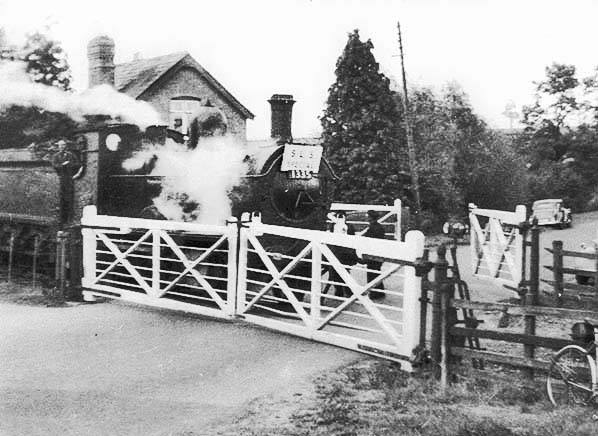 Photographs of passenger trains at Stretton-on-Fosse are not common and at the time of writing none of service trains had been located, as a result of which we must be content with railtours. Here on 31 August 1952 2-4-0 No. 1335 is seen at the level crossing with the Stephenson Locomotive Society "Shipston Branch Tour" on its way to Shipston-on-Stour. This tour and the locomotive are seen and further described in the Shipston-on-Stour pages. The train is presumably moving, although the driver (the locomotive was righthand drive) does not look particularly in control, as it had stopped short of the gates for them to be opened by the crew. When stationary the rear carriage of the four-carriage train and most of the third would have been out of the platform. This a rare view of the crossing gates closed to road traffic, in which position the gates met end-on as can be seen but when closed to the railway they overlapped. This overlapping is visible in other photographs. Photographs of passenger trains at Stretton-on-Fosse are not common and at the time of writing none of service trains had been located, as a result of which we must be content with railtours. Here on 31 August 1952 2-4-0 No. 1335 is seen at the level crossing with the Stephenson Locomotive Society "Shipston Branch Tour" on its way to Shipston-on-Stour. This tour and the locomotive are seen and further described in the Shipston-on-Stour pages. The train is presumably moving, although the driver (the locomotive was righthand drive) does not look particularly in control, as it had stopped short of the gates for them to be opened by the crew. When stationary the rear carriage of the four-carriage train and most of the third would have been out of the platform. This a rare view of the crossing gates closed to road traffic, in which position the gates met end-on as can be seen but when closed to the railway they overlapped. This overlapping is visible in other photographs.Photo from Jim Lake collection
|
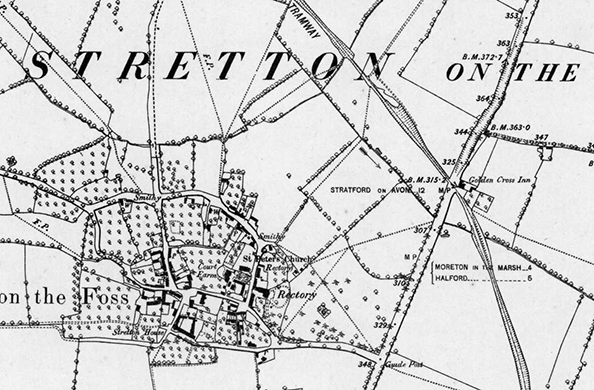
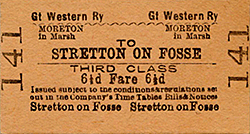 From the opening of the Shipston-on-Stour branch railway on the 1st of July 1889 ‘Golden Cross’ was provided with a level crossing keeper's cottage, which appears to have doubled as a stationmaster's house. A short goods siding had appeared by 1887. The weigh office was, as at Shipston-on-Stour, a brick structure to the standard GWR design and a goods loading gauge was provided; originally a non adjustable gauge, later replaced by a GWR adjustable type. The weighbridge and office was provided in 1906 and the office was built using blue brick as opposed to that at Shipston-on Stour which was of red brick, while Longdon Road had to make do with a diminutive wooden hut as its weigh office.
From the opening of the Shipston-on-Stour branch railway on the 1st of July 1889 ‘Golden Cross’ was provided with a level crossing keeper's cottage, which appears to have doubled as a stationmaster's house. A short goods siding had appeared by 1887. The weigh office was, as at Shipston-on-Stour, a brick structure to the standard GWR design and a goods loading gauge was provided; originally a non adjustable gauge, later replaced by a GWR adjustable type. The weighbridge and office was provided in 1906 and the office was built using blue brick as opposed to that at Shipston-on Stour which was of red brick, while Longdon Road had to make do with a diminutive wooden hut as its weigh office. 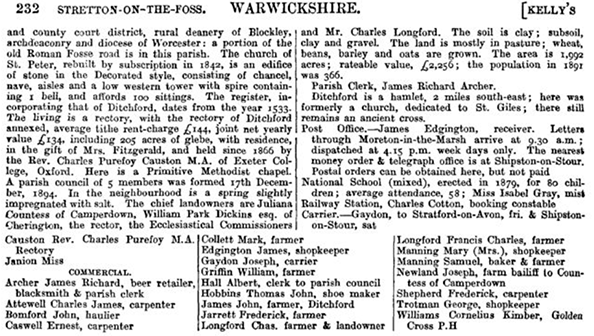

 Traffic levels, goods and passenger, were always somewhat dire and it is doubtful the temporary 1917 - 1919 closure genuinely inconvenienced many people although there were some objections. In or by 1914 there were already road services operating on the Fosse Way, calling into Stretton-on-Fosse village on the way and after WWI there was an upturn in road motor services as ex servicemen purchased military surplus motor vehicles and set up their own businesses, passenger and cartage. However these businesses, run by ex servicemen, did not spring up overnight and many servicemen were not demobbed until 1919 and in some cases later. The Allies were involved in the Army of Occupation in Europe after the signing of the Armistice on the 11th of November 1918 and WWI did not officially end until the 28th of June 1919 with the Treaty of Versailles. Thus it is not unreasonable to think the reopening of Stretton-on-Fosse on the first day of 1919 was, for a few more years anyway, its saving grace as, had the reopening been delayed any further the station may well have remained closed to passengers. In 1915 receipts for Stretton-on-Fosse were Passenger £236 and Goods £433; from which had to come wages, maintenance costs and so on let alone contribute to operating expenses of the branch as a whole.
Traffic levels, goods and passenger, were always somewhat dire and it is doubtful the temporary 1917 - 1919 closure genuinely inconvenienced many people although there were some objections. In or by 1914 there were already road services operating on the Fosse Way, calling into Stretton-on-Fosse village on the way and after WWI there was an upturn in road motor services as ex servicemen purchased military surplus motor vehicles and set up their own businesses, passenger and cartage. However these businesses, run by ex servicemen, did not spring up overnight and many servicemen were not demobbed until 1919 and in some cases later. The Allies were involved in the Army of Occupation in Europe after the signing of the Armistice on the 11th of November 1918 and WWI did not officially end until the 28th of June 1919 with the Treaty of Versailles. Thus it is not unreasonable to think the reopening of Stretton-on-Fosse on the first day of 1919 was, for a few more years anyway, its saving grace as, had the reopening been delayed any further the station may well have remained closed to passengers. In 1915 receipts for Stretton-on-Fosse were Passenger £236 and Goods £433; from which had to come wages, maintenance costs and so on let alone contribute to operating expenses of the branch as a whole. 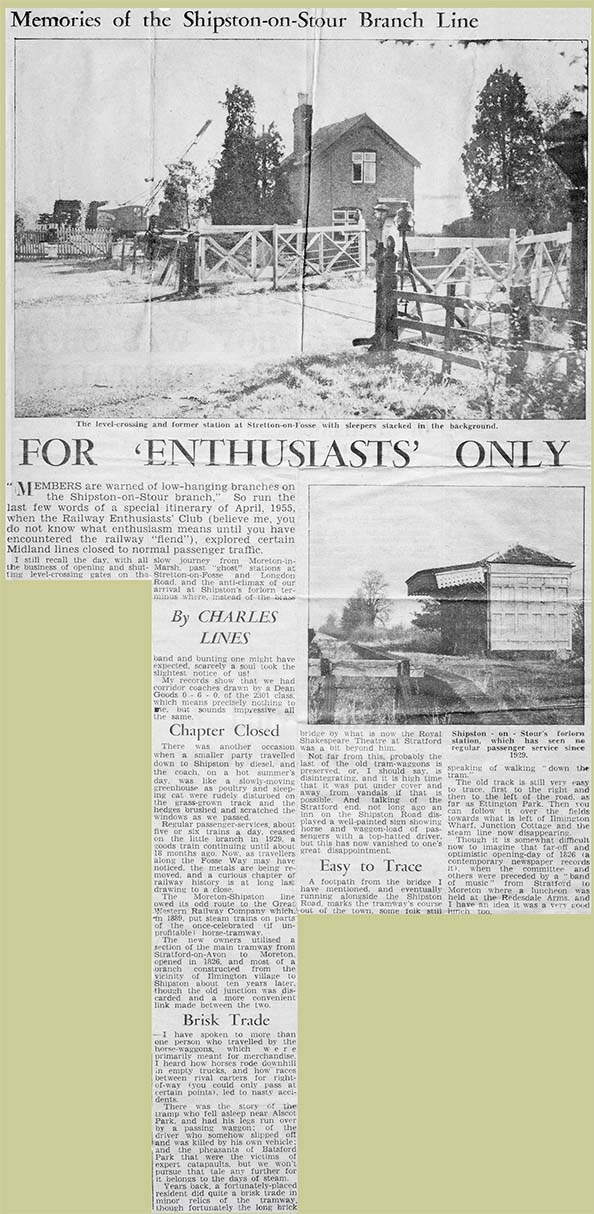

 Home Page
Home Page